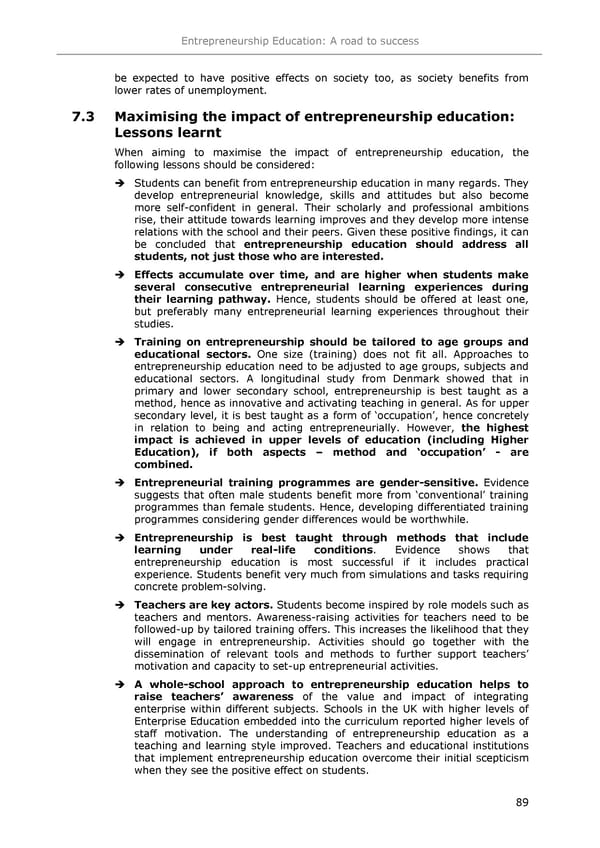Entrepreneurship Education: A road to success be expected to have positive effects on society too, as society benefits from lower rates of unemployment. 7.3 Maximising the impact of entrepreneurship education: Lessons learnt When aiming to maximise the impact of entrepreneurship education, the following lessons should be considered: Students can benefit from entrepreneurship education in many regards. They develop entrepreneurial knowledge, skills and attitudes but also become more self-confident in general. Their scholarly and professional ambitions rise, their attitude towards learning improves and they develop more intense relations with the school and their peers. Given these positive findings, it can be concluded that entrepreneurship education should address all students, not just those who are interested. Effects accumulate over time, and are higher when students make several consecutive entrepreneurial learning experiences during their learning pathway. Hence, students should be offered at least one, but preferably many entrepreneurial learning experiences throughout their studies. Training on entrepreneurship should be tailored to age groups and educational sectors. One size (training) does not fit all. Approaches to entrepreneurship education need to be adjusted to age groups, subjects and educational sectors. A longitudinal study from Denmark showed that in primary and lower secondary school, entrepreneurship is best taught as a method, hence as innovative and activating teaching in general. As for upper secondary level, it is best taught as a form of 8occupation9, hence concretely in relation to being and acting entrepreneurially. However, the highest impact is achieved in upper levels of education (including Higher Education), if both aspects – method and 8occupation9 - are combined. Entrepreneurial training programmes are gender-sensitive. Evidence suggests that often male students benefit more from 8conventional9 training programmes than female students. Hence, developing differentiated training programmes considering gender differences would be worthwhile. Entrepreneurship is best taught through methods that include learning under real-life conditions. Evidence shows that entrepreneurship education is most successful if it includes practical experience. Students benefit very much from simulations and tasks requiring concrete problem-solving. Teachers are key actors. Students become inspired by role models such as teachers and mentors. Awareness-raising activities for teachers need to be followed-up by tailored training offers. This increases the likelihood that they will engage in entrepreneurship. Activities should go together with the dissemination of relevant tools and methods to further support teachers9 motivation and capacity to set-up entrepreneurial activities. A whole-school approach to entrepreneurship education helps to raise teachers9 awareness of the value and impact of integrating enterprise within different subjects. Schools in the UK with higher levels of Enterprise Education embedded into the curriculum reported higher levels of staff motivation. The understanding of entrepreneurship education as a teaching and learning style improved. Teachers and educational institutions that implement entrepreneurship education overcome their initial scepticism when they see the positive effect on students. 89
 Entrepreneurship Education Page 92 Page 94
Entrepreneurship Education Page 92 Page 94